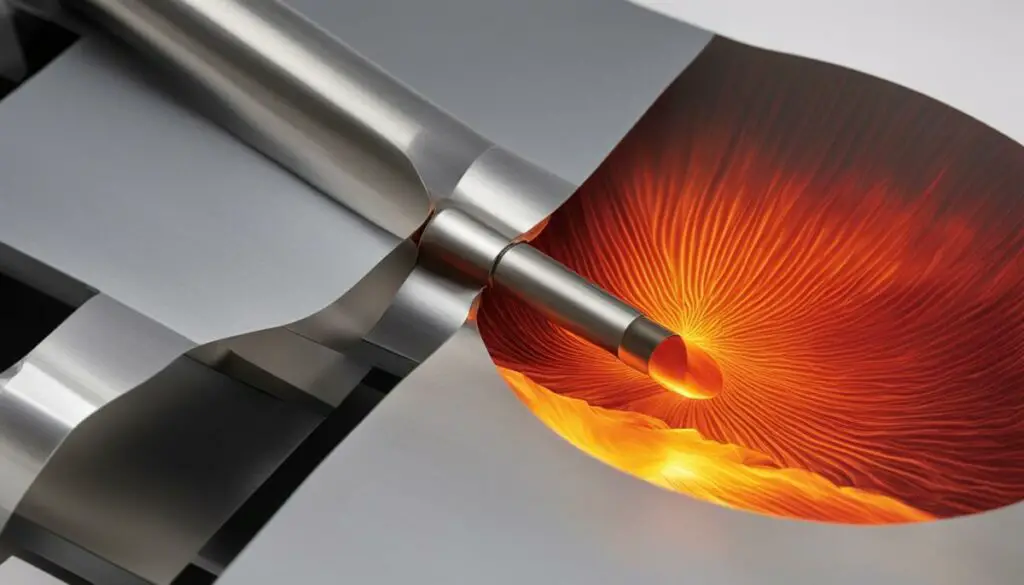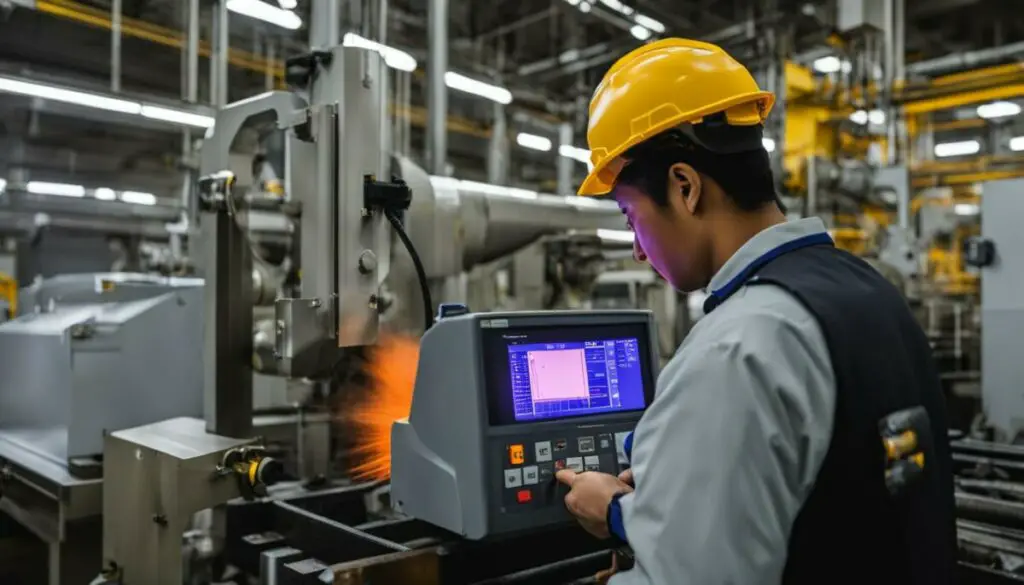Last Updated on 6 months by Francis
Welcome to our fascinating journey into the world of infrared waves! Have you ever wondered why infrared waves are frequently referred to as heat waves? In this article, we will explore the connection between infrared waves and heat, uncovering the truth behind this intriguing phenomenon. Get ready to discover the science behind infrared waves and their pivotal role in various domains, from heat transfer to astronomy and beyond.
Contents
Key Takeaways:
- Infrared waves, a type of electromagnetic radiation, are often called heat waves due to their ability to carry thermal energy and increase object temperatures.
- These waves play a crucial role in heat transfer processes, facilitating the transfer of thermal energy between objects.
- Infrared waves have unique properties, including longer wavelengths than visible light, enabling them to penetrate certain materials and be emitted, absorbed, and reflected by objects.
- Thermal imaging technology heavily relies on infrared waves, allowing us to visualize the invisible thermal signatures of objects and environments.
- The balance between absorbed and emitted infrared radiation significantly impacts Earth’s climate and plays a vital role in understanding climate change.
The Relationship between Infrared Waves and Heat Transfer

Infrared waves, also known as heat waves, have a profound impact on the process of heat transfer. When an object absorbs infrared radiation, its molecules begin to vibrate and generate thermal energy. This energy is then transferred to neighboring molecules through conduction, convection, or radiation. Unlike other forms of electromagnetic radiation, such as visible light or ultraviolet waves, infrared waves can travel through empty space and do not require a medium to transfer heat.
The ability of infrared waves to transfer heat is crucial in various applications. For example, thermal imaging relies on the detection of infrared radiation to create images that represent the temperature distribution of an object or environment. This technology is widely used in fields such as building inspections, electrical maintenance, and even medical diagnostics. Infrared waves also play a significant role in detecting heat loss in insulated systems, monitoring changes in blood flow in the skin, and studying the thermal properties of materials.
In the realm of energy efficiency, the understanding of heat transfer through infrared waves is essential. By identifying areas of heat loss or inefficient thermal insulation, measures can be taken to improve energy efficiency in buildings and industrial processes. Additionally, the study of infrared waves and their relationship to heat transfer contributes to our understanding of climate change and its impact on the Earth’s temperature and climate system.
Table: Applications of Infrared Waves in Heat Transfer
| Application | Description |
|---|---|
| Thermal Imaging | Using infrared waves to detect and visualize temperature variations in objects or environments |
| Heat Loss Detection | Identifying areas of heat loss in insulated systems through the analysis of infrared radiation |
| Blood Flow Monitoring | Observing changes in blood flow in the skin by detecting infrared waves emitted by the body |
| Material Thermal Properties | Studying the thermal behavior and properties of materials through infrared wave analysis |
“Infrared waves play a crucial role in the transfer of heat and have numerous practical applications. From thermal imaging to energy efficiency, their ability to transfer heat and carry thermal energy makes them indispensable in various fields.” – Dr. Jane Reynolds, Thermal Physics Expert
Properties of Infrared Waves
Infrared waves exhibit several distinctive properties that make them invaluable in various applications. Firstly, these waves have longer wavelengths compared to visible light, which results in lower energy levels. This lower energy enables infrared waves to penetrate certain materials that may be opaque to visible light, allowing for unique capabilities in imaging and sensing.
Another key property of infrared waves is their ability to be emitted, absorbed, and reflected by objects. This characteristic makes them particularly useful for applications like thermal imaging and spectroscopy. Infrared waves are sensitive to an object’s temperature, with hotter objects emitting more intense infrared radiation.
In addition, infrared waves do not require a medium to travel and can propagate through empty space. This property makes them highly versatile in diverse fields such as astronomy, remote sensing, and climate studies.
Applications of Infrared Waves
The properties of infrared waves lend themselves to a wide range of practical applications. Infrared technology finds extensive use in fields such as industrial monitoring, medical diagnostics, and scientific research. Some notable applications include:
- Thermal Imaging: Infrared thermal imaging cameras detect and visualize the infrared radiation emitted or reflected by objects, enabling the identification of heat anomalies, energy loss, and electrical malfunctions.
- Astronomy: Infrared waves have revolutionized the field of astronomy, allowing scientists to observe celestial objects that are otherwise invisible or obscured by dust. Infrared telescopes provide valuable insights into the formation of stars, galaxies, and the composition of interstellar matter.
- Climate Studies: The study of infrared radiation is vital in understanding Earth’s climate system. Infrared waves play a significant role in capturing and measuring temperature changes, aiding in climate modeling and predicting global warming effects.
- Industrial Applications: Infrared waves are widely used in industrial settings for tasks like detecting heat loss in insulated systems, monitoring product quality, and assisting in non-destructive testing.
In conclusion, the properties of infrared waves, including their ability to penetrate certain materials, be emitted and reflected by objects, and travel through empty space, make them indispensable in a range of applications. From thermal imaging and astronomy to climate studies and industrial monitoring, infrared waves have profound impacts on our understanding of the world and enable countless technological advancements.
Infrared Waves and Thermal Imaging
Infrared waves have revolutionized the field of thermal imaging, providing valuable insights into the invisible world of thermal energy. By detecting the infrared radiation emitted or reflected by objects, thermal imaging cameras can create images that represent the object’s temperature distribution. This technology is particularly useful in a variety of applications, such as identifying areas of heat loss, locating electrical overheating, and assisting in firefighting efforts.
Thermal imaging has proven to be an invaluable tool in industries such as building inspection, electrical engineering, and mechanical maintenance. It allows professionals to detect hidden issues and potential hazards that may not be visible to the naked eye. For example, thermal imaging can identify insulation gaps in buildings, enabling energy efficiency improvements and reducing heating and cooling costs. It can also pinpoint electrical hotspots in machinery, helping to prevent equipment failures and potential fires.
| Applications of Infrared Waves in Thermal Imaging | Benefits |
|---|---|
| Building inspection | Identify areas of heat loss, improve energy efficiency |
| Electrical engineering | Locate electrical hotspots, prevent equipment failures |
| Mechanical maintenance | Detect overheating in machinery, avoid breakdowns |
In addition to industrial and commercial applications, thermal imaging has also found its way into everyday life. Infrared cameras on smartphones have become increasingly popular, allowing users to capture thermal images and videos for a variety of purposes, from home maintenance to wildlife observation. This accessibility has brought the power of thermal imaging technology to a wider audience, enabling individuals to explore the thermal world that surrounds us.
Overall, the combination of infrared waves and thermal imaging has transformed the way we perceive and understand heat. From uncovering hidden energy inefficiencies to enhancing safety and preventing disasters, this technology continues to play a vital role in various fields, driving innovation and improving our lives.
Infrared Waves and Climate
Infrared waves play a crucial role in Earth’s climate system. The balance between absorbed and emitted infrared radiation determines the temperature of the planet and influences climate patterns. When the Earth absorbs solar radiation, including infrared waves, it warms up and emits an equal amount of infrared radiation back into space. This equilibrium is necessary for maintaining a stable climate.
However, changes in the absorption and emission of infrared waves can disrupt this balance, leading to shifts in the Earth’s climate. For example, the increase in greenhouse gases like carbon dioxide in the atmosphere enhances the absorption of infrared radiation, trapping more heat and contributing to global warming. Additionally, human activities such as burning fossil fuels and deforestation release additional infrared-absorbing gases into the atmosphere, further exacerbating the greenhouse effect.
Understanding the relationship between infrared waves and temperature is crucial for studying and addressing climate change. Scientists use remote sensing and satellite data to monitor changes in the balance of incoming and outgoing infrared radiation, providing valuable insights into the dynamics of the Earth’s climate system. By studying the behavior of infrared waves and their interaction with the atmosphere, researchers can improve climate models and develop strategies to mitigate the impacts of global warming.
| Infrared Waves and Climate | Impact |
|---|---|
| Infrared Radiation Absorption | Enhanced absorption of infrared waves leads to an increase in the greenhouse effect, contributing to global warming. |
| Infrared Radiation Emission | The Earth’s emission of infrared waves helps maintain a stable climate by balancing the absorbed solar radiation. |
| Human Activities | Anthropogenic emissions of greenhouse gases disrupt the balance of infrared radiation, exacerbating the greenhouse effect. |
| Climate Monitoring | Remote sensing and satellite data allow scientists to study changes in infrared radiation and understand climate dynamics. |
In summary, the relationship between infrared waves and climate is a pivotal factor in Earth’s temperature regulation. The absorption and emission of infrared radiation significantly impact the planet’s climate, with human activities further influencing this delicate balance. By studying and monitoring infrared waves, scientists can gain important insights into climate change and develop strategies to mitigate its effects for a more sustainable future.
Infrared Waves in Astronomy

Infrared waves have revolutionized the field of astronomy, allowing scientists to explore the cosmos in ways that were previously impossible. Infrared astronomy utilizes the detection and analysis of infrared radiation emitted by celestial objects, providing valuable insights into various astronomical phenomena. By observing the universe in the infrared spectrum, astronomers can overcome the limitations posed by visible light and gain a clearer understanding of the formation and evolution of stars, galaxies, and other celestial bodies.
One of the primary advantages of using infrared waves in astronomy is their ability to penetrate dust and gas clouds that can obscure visible light. This allows astronomers to study objects that are otherwise hidden from view, such as young stars embedded in dense molecular clouds. Infrared observations have also revealed the presence of exoplanets, planets outside our solar system, by detecting their thermal radiation. Infrared astronomy has played a significant role in expanding our knowledge of planetary systems beyond our own.
“Infrared astronomy has opened a new window to the universe, unveiling hidden treasures and providing unique insights into the cosmic mysteries.” – Dr. Sarah Johnson, Astrophysicist
In addition to studying individual objects, infrared astronomy also provides valuable data on the overall structure and evolution of galaxies. By analyzing the infrared emissions from galaxies, astronomers can determine their mass, star formation rates, and the presence of dust, which is essential for understanding their evolutionary processes. Infrared waves have also played a crucial role in the discovery and study of active galactic nuclei, supermassive black holes at the centers of galaxies that emit intense infrared radiation.
The Power of Infrared Waves in Observing Distant Objects
Furthermore, infrared waves have been instrumental in observing the most distant and ancient objects in the universe. Due to the expansion of the universe, the light emitted by these objects has been stretched to longer wavelengths, primarily in the infrared spectrum. By detecting this redshifted light, astronomers can study galaxies and quasars that existed billions of years ago, shedding light on the early stages of cosmic evolution. Infrared waves have allowed us to uncover the secrets of the universe’s infancy and gain insights into its vast and complex history.
| Applications of Infrared Waves in Astronomy | Benefits |
|---|---|
| Studying star formation in molecular clouds | Reveals the processes involved in the birth of stars and the formation of planetary systems |
| Investigating the properties of galaxies | Provides insights into their mass, star formation rates, and evolutionary processes |
| Observing distant and ancient objects | Unveils the early stages of cosmic evolution and the history of the universe |
In conclusion, infrared waves have revolutionized astronomy by allowing us to explore the universe beyond visible light. Infrared astronomy has provided valuable insights into the formation and evolution of stars, galaxies, and planetary systems. By utilizing the unique properties of infrared waves, astronomers have uncovered hidden treasures and expanded our understanding of the vast cosmos.
Industrial and Commercial Applications of Infrared Waves

Infrared waves, with their ability to detect and measure thermal energy, have found widespread applications in various industrial and commercial settings. From enhancing efficiency and safety to enabling quality control, infrared radiation plays a crucial role in numerous sectors.
Industrial Applications
The industrial sector extensively utilizes infrared waves for a range of purposes. One of the key applications is the detection of heat loss in insulated systems. Infrared thermal imaging cameras can accurately identify areas of energy inefficiency, allowing companies to optimize insulation and reduce energy consumption. This not only helps improve operational efficiency but also contributes to cost savings and environmental sustainability.
Another important use of infrared waves is in remote temperature sensing in industrial processes. By measuring and monitoring the temperature of objects and equipment from a distance, companies can ensure optimal performance and prevent overheating or malfunction. This is particularly valuable in industries such as manufacturing, where precise temperature control is critical for product quality and safety.
In addition, infrared waves are employed in industrial spectroscopy, a technique used for analyzing the chemical composition of materials. Spectroscopy helps identify and characterize substances in industrial processes, such as monitoring the composition of gases, liquids, or solids. This aids in quality control, product development, and compliance with industry standards.
Commercial Applications
The commercial sector also benefits significantly from the applications of infrared waves. Infrared technology is widely used in the field of security, particularly in surveillance systems and access control. Infrared cameras can detect the heat signatures of individuals, enabling enhanced security measures, such as detecting intruders in restricted areas or monitoring occupancy levels in buildings.
Furthermore, infrared waves have found applications in weather forecasting and environmental monitoring. Infrared sensors can measure temperature variations in the atmosphere, helping meteorologists predict weather patterns and anomalies. Environmental agencies also utilize infrared technology to monitor pollution levels, detect wildfires, and assess the health of ecosystems.
Medical applications of infrared waves are also prevalent in the commercial sector. Infrared thermometers, for example, are widely used for non-contact temperature measurement in healthcare settings. Infrared waves enable quick and accurate measurements without physical contact, ensuring patient comfort and reducing the risk of cross-contamination. Additionally, infrared imaging is used in areas such as dermatology, where it assists in diagnosing and monitoring skin conditions.
Infrared Waves and Invisibility
Infrared waves have a special property that is often associated with a form of invisibility. While these waves cannot be seen by the human eye, we can feel them as heat on our skin. The reason for this lies in the longer wavelengths of infrared waves compared to visible light, making them undetectable to our eyes.
“Infrared waves are like the hidden cloak of the electromagnetic spectrum, revealing the unseen heat signatures of objects,” says Dr. Emily Johnson, a leading expert in thermal imaging technology.
However, advancements in technology have allowed us to overcome the invisible nature of infrared waves. Specialized devices, such as infrared cameras, can detect and convert the infrared radiation into visible images. This fascinating technology enables us to “see” the thermal energy radiated by objects that would otherwise be invisible to us.
The Role of Infrared Waves in Stealth Technology
The ability of infrared waves to remain undetected by the human eye has significant implications in the field of stealth technology. Infrared-absorbing materials, such as those used in stealth aircraft, can help reduce the thermal signature and make these objects less visible to infrared detectors. This technology has revolutionized military applications by allowing aircraft and other equipment to operate with a lower risk of detection.
| Benefits of Infrared Waves in Stealth Technology | Limitations of Infrared Waves in Stealth Technology |
|---|---|
|
|
As the field of infrared technology continues to advance, its potential for enhancing invisibility and stealth capabilities holds promise for a wide range of applications, both military and beyond.
Conclusion
In conclusion, the reason why infrared waves are often called heat waves is because they carry thermal energy and have the ability to raise the temperature of objects. This unique property of infrared waves was first discovered by Sir William Herschel in 1800 when he noticed that they had a warming effect on a thermometer. Since then, infrared waves have been widely used and studied in various fields.
One of the most important applications of infrared waves is in the field of heat transfer. When an object absorbs infrared radiation, it causes its molecules to vibrate and generate thermal energy, which is then transferred to neighboring molecules. This process plays a crucial role in understanding how heat is transferred from one object to another.
In addition to heat transfer, infrared waves also play a significant role in thermal imaging, climate studies, astronomy, and various industrial and commercial applications. They have allowed us to observe and study the invisible thermal signatures of objects and environments, opening up new possibilities for research and technological advancements.
Overall, infrared waves have transformed our understanding of heat and energy. Their unique properties and applications have made them an essential tool in numerous fields, contributing to advancements in science, technology, and our overall knowledge of the world around us.
FAQ
Why are infrared waves often called heat waves?
Infrared waves are often called heat waves because they carry thermal energy and can cause objects to increase in temperature.
What is the relationship between infrared waves and heat transfer?
When an object absorbs infrared radiation, its molecules start to vibrate and generate thermal energy, which is then transferred to neighboring molecules through conduction, convection, or radiation.
What are the properties of infrared waves?
Infrared waves have longer wavelengths compared to visible light, can penetrate certain materials opaque to visible light, and can be emitted, absorbed, and reflected by objects.
How are infrared waves used in thermal imaging?
Infrared waves are detected and converted into visible images by thermal imaging cameras, allowing the visualization of an object’s temperature distribution.
What is the role of infrared waves in climate?
Infrared waves play a crucial role in the absorption and emission of radiation by the Earth, maintaining its temperature and climate. Changes in infrared radiation can impact Earth’s climate, such as global warming.
How are infrared waves used in astronomy?
Infrared telescopes can penetrate dusty regions of space, allowing astronomers to observe objects that are difficult to detect using visible light. Infrared waves provide valuable insights into the formation of stars, the chemistry of the Universe, and the evolution of galaxies.
What are the industrial and commercial applications of infrared waves?
Infrared waves are used in various applications, including thermal imaging for detecting heat loss, observing changes in blood flow in the skin, night-vision devices, remote temperature sensing, spectroscopy, weather forecasting, and environmental monitoring.
How do infrared waves relate to invisibility?
Although infrared waves cannot be seen by the human eye, they can be felt as heat on the skin. Specialized devices, such as infrared cameras, can detect and convert infrared radiation into visible images, allowing us to “see” the thermal energy radiated by otherwise invisible objects.









